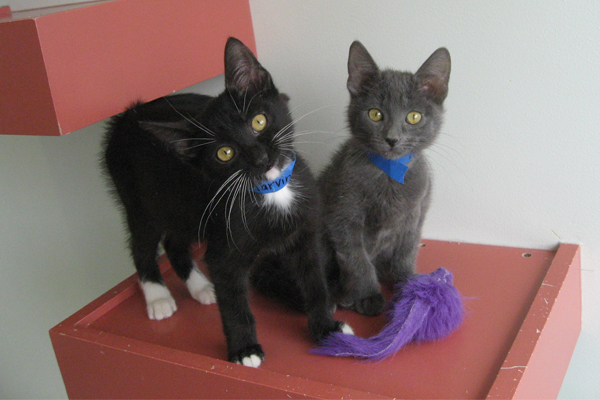The Scoop on Litterboxes
by Lisa Ward | May 01, 2009
If a cat (or cats) are part of your life, then a litterbox (or litterboxes) are too—there’s no getting around it. And while the daily effort required to maintain clean, attractive, accessible boxes—which your cat will enjoy using, and therefore use consistently—is likely nobody’s favorite chore, it is certainly preferable to dealing with the problems which can arise if your cat (or cats) develop “litterbox issues.” Litterbox problems are one of the most common behavior problems cat guardians can experience—but they can also be some of the simplest problems to solve with a bit of effort, patience and common sense.

Reasons why cats may develop an aversion to the litterbox, and solutions for resolving the issue(s):
The box is not clean enough, not of an adequate size and/or there are not enough boxes available (in homes with multiple kitties.)
- Keep the litterbox extremely clean. Scoop at least once a day (twice a day if you have multiple cats) and change the litter completely once a week. Put yourself in your kitty’s place—you prefer a clean restroom to a dirty one, right?
- Make sure your litterbox is large enough; and in a home with multiple cats, make sure you have enough boxes. If your cat doesn’t have enough room to climb into and comfortably turn around in her litterbox, it’s not big enough— replace it with a roomier one. In homes with multiple cats, a good rule of thumb is to provide one box per cat, plus one additional box, i.e., for two cats, you need three boxes. This ensures that everyone has plenty of space.
- Avoid covered litterboxes. Covered boxes trap odors inside. Even a clean covered box may not smell good to your cat. And a dirty one is (for your cat) like being in an overused port-a-potty would be for you.
The box is located inaccessibly, or, is placed too closely to the cat’s food and water dishes.
- Keep the box or boxes accessible. As tempting as it may be to place litterboxes in an out-of-the-way location, doing so does greatly increase the chances that your cat may decide to relieve themselves elsewhere. Keep the boxes centrally located, and if your home has multiple stories, be sure there are boxes on each level.
- Locate the boxes well away from the cat’s food and water dishes. Cats don’t want to eat in close proximity to their litterboxes any more than you want to eat in your bathroom.
The cat is avoiding the box because he or she is experiencing pain while in the box as a result of a medical issue.
See your vet. It's very common for cats who are sick to fail to use their litterbox, especially if the problem they are experiencing is a urinary tract infection. Only your vet can determine for certain if your kitty is sick, so check with your veterinarian right away to rule out any medical problems.
The cat has developed a fear of the box, after having been ambushed or cornered there by another cat, a child, a dog, etc.
- Alleviate the fear by ensuring that the cat has more than one exit from the litterbox. Having an “escape route” may help him or her to feel more confident.
- To whatever extent possible, prevent the ambush. This could mean separating your cats from one another, giving everyone a chance for a “time out”, or creating a “safe zone” around the litterbox vicinity by employing low gates to keep dogs or children away from the area.
The points listed above, while some of the most common reasons for litterbox issues, are by no means a comprehensive list. Your veterinarian or local rescue organization can provide you with many additional ideas and resources. The most important thing to remember is that the majority of litterbox issues can be reversed. The key is taking action sooner rather than later, and having the patience to stick with a plan until the problem has been resolved.
Outside the box?
Cleaning Tips
If your kitty has started eliminating someplace other than the litterbox, it’s important to be sure you clean up his or her “alternate restroom location” to ensure the kitty doesn’t keep returning to the same spot.
- Thoroughly soak whatever surface has been used, with an enzyme-based liquid cleaner, such as Petastic Simple Solution, Nature’s Miracle or The Eliminator. The enzymes contained in these cleaners neutralize the enzymes in the cat’s urine.
- Allow the area to thoroughly dry, then repeat.
- Once the area is completely dry for the second time, apply a 1:3 solution of white vinegar and water (one part vinegar to three parts water).
- Make sure to keep the cat away from the area being cleaned until all solutions have had a chance to completely dry.
Other suggestions
- Cat Attract brand litter contains an herb which helps to attract cats to the box; especially if your cat is already using a clay litter, switching to Cat Attract may help to solve the problem.
- Some cats have issues which require more complex solutions than those contained in this article. Once you’ve visited your veterinarian to rule out any physical reasons for the problem, you may want to take the additional step of consulting a pet behavior specialist. Your veterinarian can make suggestions of individuals they recommend. Friends and family with cats, as well as your local rescue agency, may also be able to make referrals to behaviorists.
